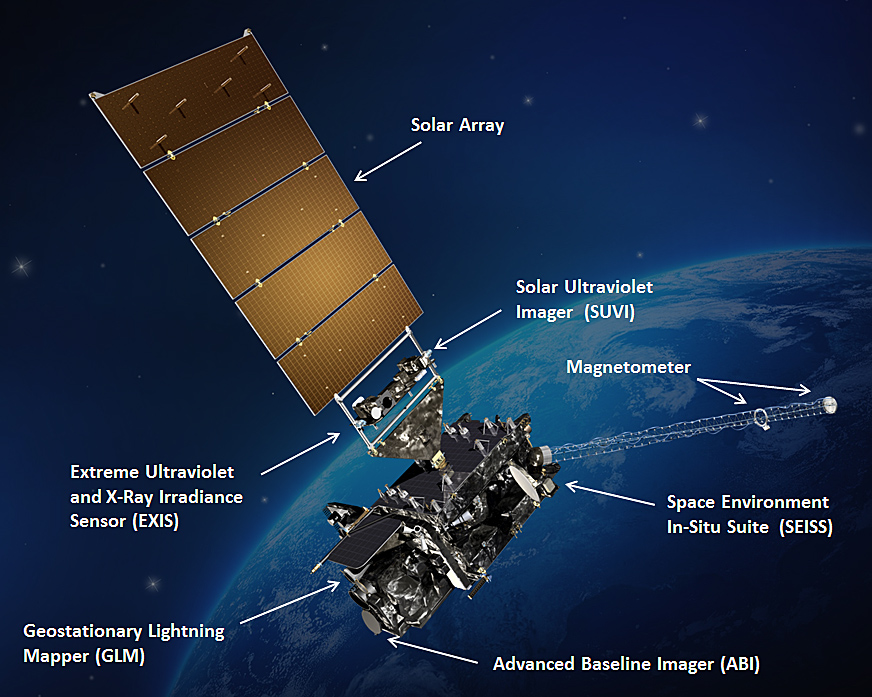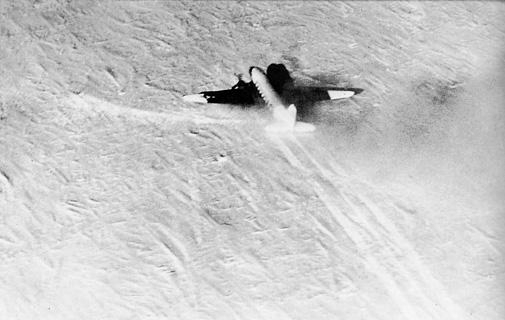|
GOES 3
GOES-3, known as GOES-C before becoming operational, was an American geostationary weather and communications satellite. It was originally built for the National Oceanic and Atmospheric Administration as part of the Geostationary Operational Environmental Satellite system, and was launched in June 1978. It was positioned in geostationary orbit, from where it was initially used for weather forecasting in the United States. After ceasing to function as a weather satellite in 1989, it was used as a communications satellite, and spent over thirty-eight years in operation. GOES-3 was decommissioned 29 June 2016 at the Center for Southeastern Tropical Advanced Remote Sensing facility in Miami, Florida. GOES-3 was built by Ford Aerospace, and was based on the satellite bus developed for the SMS programme. At launch it had a mass of . Launch GOES-C was launched using a Delta 2914 carrier rocket flying from Launch Complex 17B at the Cape Canaveral Air Force Station. The launch occurr ... [...More Info...] [...Related Items...] OR: [Wikipedia] [Google] [Baidu] |
Weather Satellite
A weather satellite or meteorological satellite is a type of Earth observation satellite that is primarily used to monitor the weather and climate of the Earth. Satellites are mainly of two types: polar orbiting (covering the entire Earth asynchronously) or geostationary (hovering over the same spot on the equator). While primarily used to detect the development and movement of storm systems and other cloud patterns, meteorological satellites can also detect other phenomena such as city lights, fires, effects of pollution, auroras, sand and dust storms, snow cover, ice mapping, boundaries of ocean currents, and energy flows. Other types of environmental information are collected using weather satellites. Weather satellite images helped in monitoring the volcanic ash cloud from Mount St. Helens and activity from other volcanoes such as Mount Etna. Smoke from fires in the western United States such as Colorado and Utah have also been monitored. El Niño and its effects on wea ... [...More Info...] [...Related Items...] OR: [Wikipedia] [Google] [Baidu] |
Satellite Bus
A satellite bus (or spacecraft bus) is the main body and structural component of a satellite or spacecraft, in which the payload and all scientific instruments are held. Bus-derived satellites are less customized than specially-produced satellites, but have specific equipment added to meet customer requirements, for example with specialized sensors or transponders, in order to achieve a specific mission. They are commonly used for geosynchronous satellites, particularly communications satellites, but are most commonly used in spacecraft which occupy low Earth orbit missions. Examples Some satellite bus examples include: * Boeing DS&S 702 * Lockheed Martin Space Systems A2100 * Moog Inc. SL-OMV, Meteor, Meteorite * * INVAP ARSAT-3K * Airbus D&S Eurostar * ISRO's I-1K, I-2K, I-3K, I-4K, I-6K, and Indian Mini Satellite bus * NASA Ames MCSB * SSL 1300 * family * Orbital ATK Star Bus family, inc GEOStar * Mitsubishi Electric DS2000 * Spacecraft bus of the Jam ... [...More Info...] [...Related Items...] OR: [Wikipedia] [Google] [Baidu] |
1978 In Spaceflight
1978 saw the launch of the Pioneer Venus missions launched by the United States, on 20 May and 8 August. The Pioneer Venus Multiprobe landed four spacecraft on the planet, one of which transmitted data for 67 minutes before being destroyed by atmospheric pressure. ISEE-C, which was launched on 8 December, flew past comet 21P/Giacobini–Zinner in 1985, and Halley's Comet Halley's Comet is the only known List of periodic comets, short-period comet that is consistently visible to the naked eye from Earth, appearing every 72–80 years, though with the majority of recorded apparitions (25 of 30) occurring after ... in 1986.Hughes, J (1996) Larousse Desk Reference Encloypedia London RD Press Launches , colspan=8 style="background:white;", January , - , colspan=8 style="background:white;", February , - , colspan=8 style="background:white;", March , - , colspan=8 style="background:white;", May , - , colspan=8 style="background:white;", June , - ... [...More Info...] [...Related Items...] OR: [Wikipedia] [Google] [Baidu] |
Rosenstiel School Of Marine, Atmospheric, And Earth Science
The Rosenstiel School of Marine, Atmospheric, and Earth Science is the University of Miami's academic and research institution for the study of oceanography, atmospheric sciences, atmospheric, and earth sciences. The Rosenstiel School is located east from the University of Miami's main Coral Gables, Florida, Coral Gables campus on Virginia Key in Miami, Florida, United States. Founded in 1943, the University of Miami's Rosenstiel School is the only subtropical applied and basic marine, atmospheric, and earth research institute in the continental United States. The school is also home to SUSTAIN, the world's largest hurricane simulation tank. Up until 2008, Rosenstiel School was solely a graduate school within the University of Miami, though it jointly administrated an undergraduate education, undergraduate program with the University of Miami's College of Arts and Sciences. In 2008, Rosenstiel School launched an undergraduate program, granting both Bachelor of Science in Mari ... [...More Info...] [...Related Items...] OR: [Wikipedia] [Google] [Baidu] |
Amundsen–Scott South Pole Station
The Amundsen–Scott South Pole Station is a science and technology in the United States, United States scientific research station at the South Pole of the Earth. It is the List of extreme points of the United States, southernmost point under the jurisdiction (not sovereignty) of the United States. The station is located on the high Antarctic Plateau, plateau of Antarctica at above sea level. It is administered by the Office of Polar Programs of the National Science Foundation, specifically the United States Antarctic Program (USAP). It is named in honor of Norwegian Roald Amundsen and Briton Robert Falcon Scott, Robert F. Scott, leaders of the competing first and second expeditions to reach the pole, in the summer of 1911–1912. The original Amundsen–Scott Station was built by Seabee, Navy Seabees for the federal government of the United States during November 1956, as part of its commitment to the Science, scientific goals of the International Geophysical Year, an ef ... [...More Info...] [...Related Items...] OR: [Wikipedia] [Google] [Baidu] |
National Science Foundation
The U.S. National Science Foundation (NSF) is an Independent agencies of the United States government#Examples of independent agencies, independent agency of the Federal government of the United States, United States federal government that supports fundamental research and education in all the non-medical fields of science and engineering. Its medical counterpart is the National Institutes of Health. With an annual budget of about $9.9 billion (fiscal year 2023), the NSF funds approximately 25% of all federally supported basic research conducted by the List of American institutions of higher education, United States' colleges and universities. In some fields, such as mathematics, computer science, economics, and the social sciences, the NSF is the major source of federal backing. NSF's director and deputy director are appointed by the president of the United States and Advice and consent, confirmed by the United States Senate, whereas the 24 president-appointed members of the ... [...More Info...] [...Related Items...] OR: [Wikipedia] [Google] [Baidu] |
University Of Hawaii
A university () is an educational institution, institution of tertiary education and research which awards academic degrees in several Discipline (academia), academic disciplines. ''University'' is derived from the Latin phrase , which roughly means "community of teachers and scholars". Universities typically offer both undergraduate education, undergraduate and postgraduate education, postgraduate programs. The first universities in Europe were established by Catholic Church, Catholic monks. The University of Bologna (), Italy, which was founded in 1088, is the first university in the sense of: *being a high degree-awarding institute. *using the word (which was coined at its foundation). *having independence from the ecclesiastic schools and issuing secular as well as non-secular degrees (with teaching conducted by both clergy and non-clergy): grammar, rhetoric, logic, theology, canon law and notarial law.Hunt Janin: "The university in medieval life, 1179–1499", McFarland, 2 ... [...More Info...] [...Related Items...] OR: [Wikipedia] [Google] [Baidu] |
Pacific Ocean
The Pacific Ocean is the largest and deepest of Earth's five Borders of the oceans, oceanic divisions. It extends from the Arctic Ocean in the north to the Southern Ocean, or, depending on the definition, to Antarctica in the south, and is bounded by the continents of Asia and Australia in the west and the Americas in the east. At in area (as defined with a southern Antarctic border), the Pacific Ocean is the largest division of the World Ocean and the hydrosphere and covers approximately 46% of Earth's water surface and about 32% of the planet's total surface area, larger than its entire land area ().Pacific Ocean . ''Encyclopædia Britannica, Britannica Concise.'' 2008: Encyclopædia Britannica, Inc. The centers of both the Land and water hemispheres, water hemisphere and the Western Hemisphere, as well as the Pole of inaccessi ... [...More Info...] [...Related Items...] OR: [Wikipedia] [Google] [Baidu] |
GOES 1
GOES-1, designated GOES-A and SMS-C prior to entering service, was a weather satellite, developed by the NASA, operated by the United States National Oceanic and Atmospheric Administration (NOAA). It was the first Geostationary Operational Environmental Satellite (GOES) to be launched. Launch GOES-A was launched atop a Delta 2914 from LC-17B at the Cape Canaveral Air Force Station. The launch occurred at 22:40:00 UTC on 16 October 1975, and left the satellite in a geostationary transfer orbit. Following launch, it raised itself to a geostationary orbit by means of its onboard SVM-5 apogee motor, at which time it was redesignated GOES-1. Operations It was positioned over the Indian Ocean to gather data for the Global Atmospheric Research Program (GARP). GOES-1 was equipped with a Visible Infrared Spin-Scan Radiometer (VISSR), which provided day and night imagery of terrestrial cloud conditions. It returned its first image on 25 October 1975, nine days after launch. ... [...More Info...] [...Related Items...] OR: [Wikipedia] [Google] [Baidu] |
Geostationary Transfer Orbit
In space mission design, a geostationary transfer orbit (GTO) or geosynchronous transfer orbit is a highly elliptical type of geocentric orbit, usually with a perigee as low as low Earth orbit (LEO) and an apogee as high as geostationary orbit (GEO). Satellites that are destined for geosynchronous orbit (GSO) or GEO are often put into a GTO as an intermediate step for reaching their final orbit. Larson, Wiley J. and James R. Wertz, eds. Space Mission Design and Analysis, 2nd Edition. Published jointly by Microcosm, Inc. (Torrance, CA) and Kluwer Academic Publishers (Dordrecht/Boston/London). 1991. Manufacturers of launch vehicles often advertise the amount of payload the vehicle can put into GTO. Background Geostationary and geosynchronous orbits are very desirable for many communication and Earth observation satellites. However, the delta-v, and therefore financial, cost to send a spacecraft to such orbits is very high due to their high orbital radius. A GTO is an intermedia ... [...More Info...] [...Related Items...] OR: [Wikipedia] [Google] [Baidu] |






